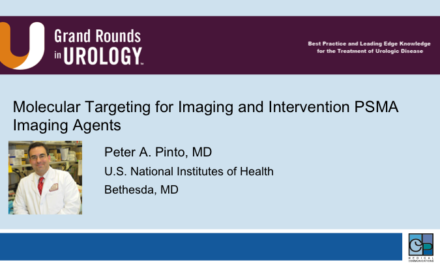This is presentation four of five of the CME accredited program, “The Multidisciplinary Approach to Treating Prostate Cancer Using Radiopharmaceuticals.” Please complete all lectures before completing the “CME Post-Test.”
Keywords: prostate cancer, radium-223, osseous metastatic disease
How to cite: Koo, Phillip J. “Osseous Metastatic Disease and Radium 223: Lessons Learned and Future Directions.” Grand Rounds in Urology. November 6, 2016. Accessed Dec 2024. https://dev.grandroundsinurology.com/prostate-cancer-phillip-koo-osseous-metastatic-disease-and-radium-223/.
CME POST-TEST
Thank you for participating in the CME activity.
For CME credit, visit Medical College of Wisconsin. Immediately upon passing the online test, you will receive your certificate via email.
Transcript:
Osseous Metastatic Disease and Radium 223: Lessons Learned and Future Directions
Radium 223 was first approved by the FDA in May of 2013, so it’s been three and a half years so I thought it’d be a good opportunity to sort of talk about my own experience and the lessons I learned and where I think we’re headed in the future. Just note that this perspective comes from someone who is a nuclear radiologist. So, I’m not really on the front lines as all of you are, but I’m the person who’s been administering this drug to our patients, where we get referrals from our urology and oncology colleagues. And it also has an impact as well because we’re the ones who detect a lot of this disease that allows them to be eligible. Just my perspective.
Disclosures. This slide, I’m going to try to present the evidence when it’s available. Sometimes though, there’s not the perfect clinical trial or the perfect data that shows how to do things, and I think this is just my own experience that I’ve learned over the past three years.
I think it’s interesting because as a nuclear radiologist, we weren’t really involved in the treatment of patients with prostate cancer. People talk about samarium and strontium but that really wasn’t a very big part of our practice and when we did administer those drugs, it was for a different endpoint. So, now that we were being thrust into the therapeutic arena, it sort of changed the way we needed to approach patients. So, a lot of this, again, is just personal reflection on this journey.
For those of you who aren’t familiar with Radium 223, it’s a targeted radium pharmaceutical. It’s a calcium emetic, so it’s injected intravenously, it localizes in the bones, it gives off an alpha particle. An alpha particle is special because it contains more energy and it travels a shorter distance. So, it packs a stronger punch and it actually delivers that punch over a significantly shorter distance, which then leads to less marrow complications, which is a huge advantage to this drug compared to the – – and the other drugs we’ve used in this space.
It turns out that the treatment of these bone mets in that manner led to an increase in overall survival, and the indication for this drug is patients who are castration resistant with no known visceral metastases and who are symptomatic. We’ll talk about this, but it’s symptomatic; it’s not just painful bone metastases.
So, this is the first lesson I learned and this is a phrase I stole from Dr. Crawford. Bone mets is a sentinel event—seminal event actually, not sentinel—seminal event. And the more and more I learn about this, the more and more I learn how true it is.
So, it’s a significant cause to morbidity and mortality; higher risk of death, higher risk of skeletal-related events, increased morbidity, higher treatment costs, lower quality of life; all bad things that are associated with bone metastases.
This comes from the Norgaard data that looks at overall survival and whether they have bony metastases. So, this first line, no bone mets with survival here on the Y axis and years on the X axis, and in these two lines here, the top one is just bone mets and then the one below is bone mets with a skeletal-related event. Again, most of these are much, much worse compared to those patients who do not have a diagnosis of bone metastases.
From our perspective, when we’re reading bone scans or just various imaging studies, I think it actually is a very big deal when we can detect a bony met, which in the past I think we looked at images differently. So, I think now it’s important for radiologists to look at it from the clinical context and I think we’re seeing a change in the culture in radiology to sort of embrace more of the clinical sides as well, especially as we’ve become more subpoena-specialized in radiology and nuclear medicine.
I’m a big believer in early intervention, and think we’ve heard that phrase talked about pretty frequently here during this meeting.
This looks at overall survival and bone metastases. So, overall survival if you have one to four bone mets versus greater than equal to five bone mets, your survival goes down significantly and your progression-free survival also goes down, and this comes from the British Journal, BJU International in 2014. So, the volume in mets has a difference as well.
Looking at making the case for early intervention, I think there’s various ways we can sort of make that argument. It’s not the most tight argument but I think it’s there. We looked at the data from ALSYMPCA—which that’s an error—but those patients who had an alk phos of less than 220 had overall survival of 17 months versus those who had an alk phos greater than 220—that was 11.4 months. And then the box in the top left, that comes from, I believe, Fred Saad from EAP data that he presented at ASCO 2015, but again, similar findings—less than 220, the overall survival was not estimable; greater than 220, it was ten months, and that had a P value of less than .001.
So, then we had this study here. This comes from MD Anderson in Houston that actually looked at total burden of bone metastases on a sodium fluoride PET/CT, and he looked at this and then they stratified it based on whether—they created this quantitative value and whether or not it was less than 8,000 total lesion fluoride uptake, or something like that, versus greater than or equal to 8,000, and if it was greater than 8,000, your survival wasn’t nearly as good as it was if it was less than that. So, total bony mets in response and overall survival were very different in these two groups.
I think the biggest reason why I think early intervention is the most important part of this is because if we treat earlier, the likelihood of them completing therapy increases. So, patient with less prior therapy completed more cycles. This comes from Dr. Sartor, who presented this at ASCO 2015. And then there’s a new paper out of Dana-Farber Cancer Institute that was recently published that talked about clinical parameters which reflect earlier disease stage were associated with therapy completion, and he looked at values such as hemoglobin, LDH, alk phos and things like that, but basically parameters that reflected earlier disease stage. Those patients tended to get all five or six doses of Radium 223. Interestingly, in that study they showed that concurrent abiraterone and previous sip-T were associated with more therapies, mostly likely due to patient selection.
Why is that a big deal? Because we’re seeing data that shows that if you complete the therapy—at least get five doses, if not the total six—your overall survival benefit probably goes up. So, there’s this study. It was a single-site MD Andersons experience with Radium 223 since beginning, and they showed that total Radium cycles in abiraterone were associated with overall survival, progression-free survival and bone-event free survival. So, those patients who got five or six doses tended to do better than those who did not.
This study comes from that same study from Dana-Farber, that showed higher mortality in patients in the group of patients receiving less than five doses versus greater than five doses—51% versus 30%.
Second lesson; it’s not a—this should say pain palliative therapy. So, this is not indicated to relieve pain. And I think from the nuclear medicine perspective, I think we’re having trouble getting past this paradigm because we’ve only known samarium and strontium for the past 30, 40 years, and those were just meant to relieve pain. But this is, again, a different class of drug.
This comes from the ALSYMPCA trial that looked at overall survival, which was significant compared to those who received placebo, and then time to first symptomatic skeletal event, which again, was also significant compared to those who received placebo. So, it’s an overall survival benefit that you get with this drug as opposed to a pain relief. And then a secondary benefit is the time to your first symptomatic skeletal event is longer. These are things that the other drugs, such as samarium and strontium could never say, never proven.
So, if we talked about pain and we counseled our patients about pain, we’d be doing them a disservice, because this data comes from Chris Sweeney at ASCO in 2015. Only 42% of patients reported improved pain, which depends on how you look at it, maybe that’s good, maybe that’s bad, but I hesitate to have patients expect that response when only 42% of them are going to get that response. 18% had no change, 28% actually had worse pain—and that usually occurs in the first two doses of the drug, which is probably some sort of flare response—and then 10% reported some improvement and some worsening. So, again, if we’re thinking about this therapy as something that’s going to relieve their pain, I think it’s the wrong perspective. It’s really about the survival benefit.
Lesson number three that I’ve learned. I’ve learned that pain is not the only symptom, and again, from the nuclear radiologist’s perspective, when we talked about radiopharmaceuticals, we always just focused on pain, how to relieve pain. That’s our role of relieving pain. But pain isn’t the only symptom, and now that I’ve met a lot of these patients in the clinic, doing consents and administering this drug, you realize that men are very hesitant to talk about pain or admit pain. They circumvent the question, and as Dr. Crawford talked about yesterday, it’s usually the spouses who come with them that really tell the whole story. So, I think it’s important for us to recognize that and recognize that it’s symptoms, and the label for this is for symptomatic bone metastases, not necessarily painful bone metastases. And I’ve heard Dr. Vogelstein talk about this, how if you wait until they have pain, you’re actually waiting too long.
So, I think if we think about symptoms differently, there’s a lot of other symptoms that are caused by these bony metastases—changes in behavior, daily activities or change, sleep patterns or change, nonverbal indicators—and I think we’re going to see more and more data come out on this in the next 6 to 12 months.
Again, the indication is for symptomatic bone mets, not painful bone metastases.
Lesson number four; personally, I found that PSA and imaging are not good biomarkers. So, when we start these therapies, I’ve seen places measure PSAs at every single cycle. So, it’s basically a 20-week cycle, you get six doses over 20 weeks, they come visit us every four weeks. Some places will get a PSA, some people get imaging after three months and after completion of therapy. I’ll tell you sort of how I do things afterwards.
The PSA from the ALSYMPCA trial shows that PSA does not have a response. There was no response. Those who received placebo and those who received Radium, their median time to increase in PSA level was the same.
This comes from the Dana-Farber data that looked at PSA values and number of completed therapies, and you see those patients who had a rise in PSA tended to get less doses of Radium 223. You could make the argument that the rise in PSA was probably an indicator of their progressing disease—and I don’t disagree with that—but then again, from my perspective, whenever I start a patient on this drug, my goal and what I tell them from the start is hey, we want to get you as many doses of this as possible, as long as we’re safe, because we know that if we can get all these doses in, you’re going to get the survival benefit. So, tough to really digest this data but I think PSA, in and of itself, isn’t a great barter for response.
So, imaging, I think, is a very tricky issue. As an imager, you would think I’d want to do more imaging than less, but when it comes to Radium 223, I think less is actually better, and I know MD Anderson in Houston will do imaging at baseline after the third dose and after their sixth dose. To me, I don’t really see the value in doing imaging after their third dose because it doesn’t really tell us much. We think about flare. It hasn’t really been talked about much in the literature. There is one case report that I just recently read out of Duke that talked about a flare response. Maybe it’s true, maybe it’s not. Some patients have had remarkable responses on bone scans after two, three doses of Radium 223. I just don’t think we know enough at the moment to be recommending routine imaging. I think the role for imaging is to detect visceral metastatic disease if clinically there is the suspicion for visceral mets. And following PSA, I guess, for that value might be of worth. So, if you are going to do imaging, get a contrast in the NCT, make sure there are no liver mets or visceral mets that develop in the intern. Again, nodal mets are okay.
I think alk phos is probably where we should be focusing on. Patients with a 30% reduction in total alk phos, it was 47% versus 3% in the placebo, and actually 34% of patients had a normalization of their alk phos as opposed to just 1% in patients who received placebo. So, alk phos seems like it’s a better biomarker. And in those patients who did have a normalized alk phos, their survival was 102 weeks versus 58 weeks.
This data comes from ESMO this past fall, just a couple of months ago, that talked about alk phos as a biomarker, and in their study they had 57% of patients who had a decrease in their alk phos and they had 43 patients who did not. Those patients who had a decrease in their alk phos actually had a 70% decrease in their risk of death, they had a 53% decrease in their risk of symptomatic skeletal event and the responders were more likely to receive five to six doses. So, alk phos tends to be the lab or the biomarker that we track more closely during our Radium therapies.
Future directions; I think combinations are where we’re headed, and there’s this combination trial currently being conducted using it with abiraterone. And speaking anecdotally, when we see patients who are on abiraterone concurrently with this, they seem to do a lot better. And then we have the single-site studies from MD Anderson and now Dana-Farber that talk about better results with patients who are receiving abiraterone concurrently. It makes sense. The mechanisms of action are completely different. There are no cross-toxicities. Because the Radium 223 is very basic. It localizes in bones and just gives off an alpha particle. So, the mechanisms of action are completely different. And Radium 223 does not hit soft tissue disease. So, it makes sense that you would hit the soft tissue disease and the bony disease simultaneously.
I think retreatment is another area. This is going to take longer to prove, but retreatment is exciting. We’ve had a lot of patients who have had great responses to this. It’s been safe and they’re asking us for more therapies, but again, we don’t have that data yet, but I think if we could push this a little earlier—because I think patients will benefit from this—then we could actually revisit retreatment later down the line.
Thank you for your attention.
ABOUT THE AUTHOR
Phillip J. Koo, MD, is the Division Chief of Diagnostic Imaging and Northwest Region Oncology Physician Executive at the Banner MD Anderson Cancer Center in Phoenix, Arizona. Prior to this, he was Chief of Nuclear Medicine and Associate Professor of Radiology at the University of Colorado School of Medicine. Dr. Koo completed his transitional internship at the University of Pennsylvania Medical Center-Presbyterian, his radiology residency at Pennsylvania Hospital of the University of Pennsylvania Health System, and his fellowship at the Harvard Medical School Joint Program in Nuclear Medicine. He is a diplomate of both the American Board of Radiology and the American Board of Nuclear Medicine. Dr. Koo is an active member of multiple societies and has served as the Chair of Nuclear Medicine for the RSNA Scientific Program Committee, Chair of the Quality and Evidence Committee for the Society of Nuclear Medicine and Molecular Imaging (SNMMI), and Chair of the Prostate Cancer Working Group at the SNMMI. Dr. Koo has published on various topics related to radiology and nuclear medicine in multiple journals such as Radiology, Radiographics, the European Journal of Nuclear Medicine and Molecular Imaging, Urology, and the Journal of the American College of Radiology.





